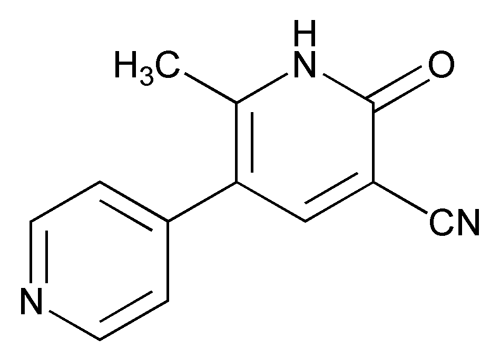Milrinone
(mil' ri none).
» Milrinone contains not less than 98.5 percent and not more than 101.5 percent of C12H9N3O, calculated on the anhydrous basis.
[Caution—Milrinone is a cardiotonic agent.
]
Packaging and storage—
Preserve in tight containers, and store at controlled room temperature.
USP Reference standards  11
11 —
—
USP Milrinone Related Compound A RS
1,6-Dihydro-2-methyl-6-oxo-(3,4¢-bipyridine)-5-carboxamide.
C12H11N3O2 229.23
1,6-Dihydro-2-methyl-6-oxo-(3,4¢-bipyridine)-5-carboxamide.
C12H11N3O2 229.23
Identification—
B:
The retention time of the major peak in the chromatogram of the Test solution corresponds to that in the chromatogram of the Standard solution, as obtained in the test for Chromatographic purity.
Water, Method I  921
921 :
not more than 2.0%.
:
not more than 2.0%.
Residue on ignition  281
281 :
not more than 0.2%.
:
not more than 0.2%.
Heavy metals, Method II  231
231 :
0.002%.
:
0.002%.
Chromatographic purity—
pH 7.5 Phosphate buffer—
Dissolve 2.7 g of dibasic potassium phosphate in 800 mL of water, add 2.4 mL of triethylamine, adjust with phosphoric acid to a pH of about 7.5, and mix.
Mobile phase—
Prepare a filtered and degassed mixture of pH 7.5 Phosphate buffer and acetonitrile (80:20). Make adjustments if necessary (see System Suitability under Chromatography  621
621 ).
).
Standard stock solution—
Dissolve an accurately weighed quantity of USP Milrinone RS in Mobile phase to obtain a solution having a known concentration of about 2 mg per mL, heat in a water bath at approximately 80 , and/or sonicate, if necessary.
, and/or sonicate, if necessary.
Standard solution—
Dilute an appropriate volume of Standard stock solution quantitatively, and stepwise if necessary, with Mobile phase to obtain a solution having a known concentration of 0.006 mg per mL.
System suitability solution—
Dissolve an accurately weighed quantity of USP Milrinone Related Compound A RS in Mobile phase to obtain a solution having a known concentration of about 0.2 mg per mL. Heat in a water bath at approximately 80 , and/or sonicate, if necessary, to dissolve. Transfer 10.0 mL of this solution and 1.0 mL of the Standard stock solution to a 100-mL volumetric flask, dilute with Mobile phase to volume, and mix.
, and/or sonicate, if necessary, to dissolve. Transfer 10.0 mL of this solution and 1.0 mL of the Standard stock solution to a 100-mL volumetric flask, dilute with Mobile phase to volume, and mix.
Test solution—
Transfer about 100 mg of Milrinone, accurately weighed, to a 50-mL volumetric flask, dissolve in and dilute with Mobile phase to volume, and mix. Heat in a water bath at approximately 80 , if necessary.
, if necessary.
Chromatographic system (see Chromatography  621
621 )—
The liquid chromatograph is equipped with a 220-nm detector and a 4.6-mm × 25-cm column that contains packing L7. The flow rate is about 1 mL per minute. Chromatograph the System suitability solution, and record the peak responses as directed for Procedure: the relative retention times are about 0.6 for milrinone related compound A and 1.0 for milrinone; the resolution, R, between milrinone related compound A and milrinone is not less than 4.0; and the relative standard deviation for replicate injections of milrinone is not more than 5.0%.
)—
The liquid chromatograph is equipped with a 220-nm detector and a 4.6-mm × 25-cm column that contains packing L7. The flow rate is about 1 mL per minute. Chromatograph the System suitability solution, and record the peak responses as directed for Procedure: the relative retention times are about 0.6 for milrinone related compound A and 1.0 for milrinone; the resolution, R, between milrinone related compound A and milrinone is not less than 4.0; and the relative standard deviation for replicate injections of milrinone is not more than 5.0%.
Procedure—
Separately inject equal volumes (about 20 µL) of the Test solution and the Standard solution into the chromatograph, record the chromatograms, and measure all the peak responses. Calculate the percentage of each impurity in the portion of Milrinone taken by the formula:
5000(C/W)(ri / rS)
in which C is the concentration, in mg per mL, of USP Milrinone RS in the Standard solution; W is the weight, in mg, of milrinone taken to prepare the Test solution; ri is the peak response for each impurity obtained from the Test solution; and rS is the peak response obtained from the Standard solution: not more than 0.3% of any individual impurity is found; and not more than 1.0% of total impurities is found.
Assay—
Transfer about 200 mg of Milrinone, accurately weighed, to a 100-mL beaker, and dissolve by stirring in 50 mL of glacial acetic acid. Titrate with 0.1 N perchloric acid VS, determining the endpoint potentiometrically. Perform a blank determination, and make any necessary correction. Each mL of 0.1 N perchloric acid VS is equivalent to 21.12 mg of C12H9N3O.
Auxiliary Information—
Please check for your question in the FAQs before contacting USP.
| Topic/Question | Contact | Expert Committee |
|---|---|---|
| Monograph | Sujatha Ramakrishna, Ph.D.
Senior Scientific Liaison 1-301-816-8349 |
(SM22010) Monographs - Small Molecules 2 |
| Reference Standards | RS Technical Services 1-301-816-8129 rstech@usp.org |
USP35–NF30 Page 3924
Pharmacopeial Forum: Volume No. 29(5) Page 1538

